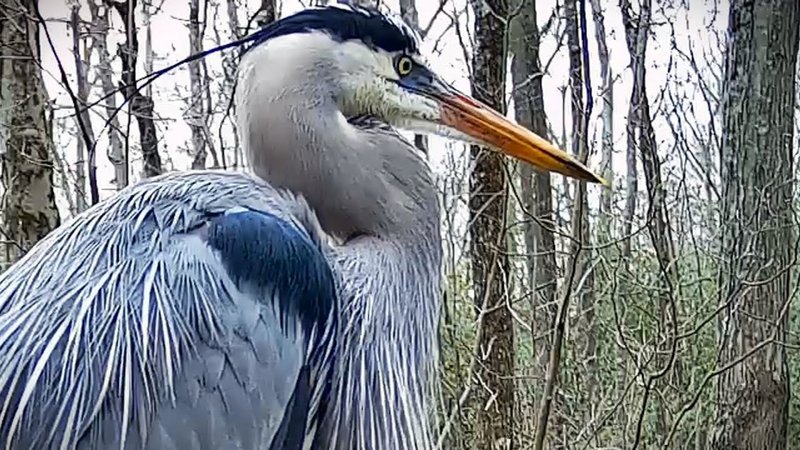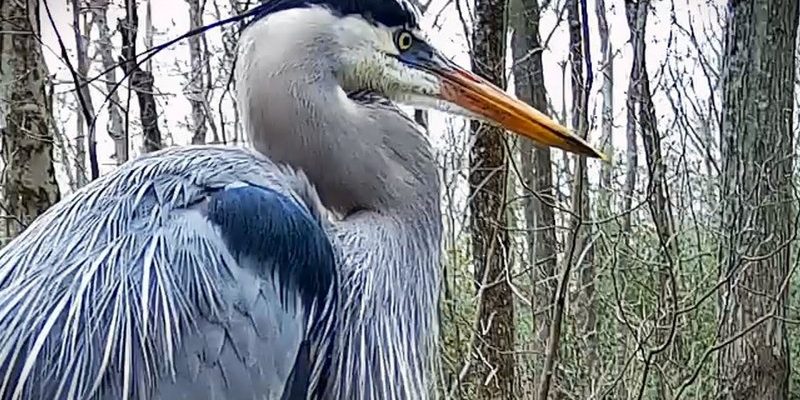
Have you ever seen a bird that looks like it stepped out of a painting? That’s the Great Blue Heron for you. With its long legs, graceful neck, and striking blue-gray feathers, this bird captivates anyone lucky enough to spot it. Imagine a tall, elegant figure standing still by a pond, its sharp beak poised for a quick strike—this is exactly what the Great Blue Heron does best.
These magnificent birds can often be seen along coastlines, rivers, and wetlands. They have a unique knack for blending into their surroundings, making them both fascinating and a bit elusive. Learning about the Great Blue Heron can give you a deeper appreciation for nature and its wonders. Let’s delve into the life of this remarkable bird and uncover what makes it so special.
Physical Characteristics
The Great Blue Heron is an impressive sight to behold. On average, they stand about 4 to 5.5 feet tall and have a wingspan that can reach 6 to 7 feet. This means they are one of the largest herons in North America, second only to the Great Egret. Their feathers are mostly a beautiful blue-gray, with a striking white head and a black crown. This color helps them blend into their wetland habitats, giving them a stealthy advantage when hunting.
One of the most distinctive features is their long legs and neck. These adaptations allow Great Blue Herons to wade through shallow water and catch fish with precision. Their beaks are long and sharp, perfect for spearing fish, frogs, and even small mammals. In fact, these birds are skilled hunters and can catch prey with incredible speed, sometimes striking in less than a second!
You might notice that these herons have a unique way of flying as well. They fly with their necks tucked in, which can make them look even taller in the air. When they take off, their large wings create quite the spectacle, and you may hear the sound of their wings flapping against the wind. It’s truly a sight to see—and one you’ll remember if you have a chance to observe them in flight!
Habitat and Range
Great Blue Herons are adaptable birds found in a variety of habitats across North America. They prefer wetlands, marshes, and shores, but can also thrive in urban settings where there’s water nearby. These birds are commonly seen in both freshwater and saltwater environments, making them quite versatile. Their ability to adapt to different settings allows them to be found from the southern parts of Canada all the way down to the Gulf of Mexico.
What’s truly fascinating is that, while they primarily stay near water, they also require trees or large shrubs nearby for nesting. They often build their nests in colonies, known as heronries, which can house many pairs of birds. By nesting in groups, Great Blue Herons benefit from the safety in numbers, helping to protect their young from predators.
In colder regions, such as in northern Canada, Great Blue Herons migrate south for the winter. They tend to follow warm currents and find suitable feeding grounds in the southern states. This migration pattern is a testament to their resilience and ability to find food even in changing environments.
Diet
The diet of the Great Blue Heron is as varied as its habitat. These birds primarily feast on fish, but they also enjoy other aquatic creatures like frogs, insects, and crustaceans. Their hunting technique can be described as ‘still hunting’—they patiently wait, often motionless, allowing prey to come close enough for a quick strike. This method requires a lot of patience but is highly effective.
Interestingly, Great Blue Herons also have a unique way of hunting together. Sometimes you’ll see them foraging side by side, even with other birds! They can create a sort of hunting team, making it easier to catch fish as they stir up the water. This social behavior is quite remarkable and shows how they can adapt their hunting strategies based on their environment.
Their diet isn’t limited to just fish, though. They are opportunistic feeders and will also eat small mammals and even birds if the opportunity arises. This flexibility in diet helps them survive in various habitats and conditions, making them resilient hunters with a diverse palate.
Reproduction and Nesting
When it comes to reproduction, Great Blue Herons are quite dedicated. Mating typically occurs in the spring, and pairs engage in elaborate courtship displays that include synchronized flying and dancing. Once they mate, they work together to build a sturdy nest, often high in trees, using sticks, reeds, and other materials available in their environment. This teamwork is vital as it helps create a safe environment for their young.
The female usually lays between 2 to 6 eggs, which she and her mate take turns incubating for about 28 to 30 days. After hatching, the chicks are not immediately independent. Instead, they rely on their parents for food and protection. During this time, it’s fascinating to watch the chicks grow as they develop their feathers and learn to stretch their wings.
As the young herons mature, they begin to practice their flying skills. They often leave the nest after about two to three months, but they may continue to rely on their parents for food for a little while longer. This nurturing phase is crucial, as it helps the hatchlings gain the skills they need to survive on their own in the wild.
Behavior and Social Structure
Great Blue Herons are generally solitary creatures, but they can also be seen in small groups, especially during feeding. When resting, they often stand on one leg, a posture that may help them conserve body heat. You might find them watching the water intently, their focus unwavering as they wait for the perfect moment to strike.
These birds have a range of vocalizations, from soft croaks to louder squawks, especially during mating season. The sounds serve various purposes, such as establishing territory or calling to a mate. When you hear a Great Blue Heron communicate through its calls, it adds another layer to their already charismatic presence.
Another fascinating aspect of their behavior is their ability to adapt to human presence. In some urban areas, you may find them fishing in parks or ponds, showing that they can coexist with people—provided there’s a consistent food source. This adaptability makes them a wonderful reminder of nature’s resilience even in changing environments.
Conservation Status
While the Great Blue Heron is not currently considered endangered, it still faces threats from habitat loss and pollution. Wetland draining for urban development and agriculture has significantly reduced their natural habitats. Additionally, water pollution can affect their food sources, which ultimately impacts their health and reproductive success.
Efforts are being made to conserve wetlands and restore habitats that support not only Great Blue Herons but many other wildlife species. Organizations dedicated to protecting these environments play a critical role in ensuring that future generations can enjoy these magnificent birds. Every action counts, whether it’s voting for environmental protections or getting involved in local conservation efforts.
By educating ourselves and others about the challenges these birds face, we can contribute to their preservation. The more we understand and appreciate the Great Blue Heron and its habitat, the better equipped we are to help protect them. Together, we can make a difference and ensure that these stunning birds continue to grace our ecosystems.
| Characteristic | Description |
| Height | 4 to 5.5 feet |
| Wingspan | 6 to 7 feet |
| Weight | 4 to 5.5 pounds |
| Diet | Fish, frogs, insects, small mammals |
| Breeding Season | Spring |
| Eggs per Clutch | 2 to 6 eggs |
| Incubation Period | 28 to 30 days |
| Typical Lifespan | 15 years in the wild |
FAQ
How can I attract Great Blue Herons to my backyard?
To attract Great Blue Herons, you’ll want to provide a suitable water feature, like a pond or stream. Make sure the water is clear and has plenty of fish or other small aquatic life. Adding some tall grasses or plants around the edges can provide cover and make your yard more inviting. Remember, they prefer quiet spaces, so minimizing noise and disturbance is key.
What is the difference between a Great Blue Heron and a Great Egret?
The Great Blue Heron and the Great Egret are often confused due to their size and habitat preferences. However, their most notable difference is their color. The Great Blue Heron has blue-gray feathers, while the Great Egret is entirely white. Additionally, the heron has a heavier build and a longer neck compared to the more slender Great Egret.
Are Great Blue Herons social birds?
Great Blue Herons are generally solitary but can be found in small groups, especially during feeding or when nesting. They often create heronries, which are colonies where multiple pairs nest together. This social structure is primarily for protection, as nesting in groups can help shield young birds from predators.
Do Great Blue Herons migrate?
Yes, Great Blue Herons do migrate to some extent. In colder regions, they typically move south in the fall to avoid freezing temperatures. They seek areas with open water where they can continue to find food during the winter months. Their migration patterns can vary based on local conditions and food availability.
What do Great Blue Herons eat?
Great Blue Herons primarily eat fish, but their diet can also include frogs, small mammals, and insects. These birds are opportunistic feeders and will hunt whatever is available in their environment. Their hunting style is fascinating; they often stand still for long periods, waiting patiently for their prey to come close before striking.
How long do Great Blue Herons live?
In the wild, Great Blue Herons can live up to about 15 years. However, their lifespan can be influenced by various factors, including habitat quality, availability of food, and predation. In some cases, those living in more protected areas or with ample resources may live longer.
What are the main threats to Great Blue Herons?
The primary threats to Great Blue Herons include habitat loss due to urban development, pollution, and climate change. Deteriorating water quality affects their food sources, while draining wetlands reduces their nesting and feeding areas. Conservation efforts are crucial to protect these habitats and ensure the future of Great Blue Herons.
How can I help in conservation efforts for Great Blue Herons?
You can help by supporting local conservation organizations that work to protect wetlands and wildlife habitats. Participating in or donating to restoration projects can have a significant impact. Additionally, spreading awareness about the importance of preserving ecosystems can encourage others to take action as well.
Are Great Blue Herons aggressive?
While Great Blue Herons are generally not aggressive toward humans, they can be territorial, especially during nesting season. They may display defensive behaviors, such as flaring their feathers or making loud calls to ward off threats. It’s essential to observe these birds respectfully from a distance to avoid stressing them.
What time of year do Great Blue Herons breed?
Great Blue Herons typically begin breeding in the spring. This is when they perform courtship displays and build nests. After laying eggs, both parents take turns incubating them for about 28 to 30 days, eventually leading to the hatching of their chicks.
Can I see Great Blue Herons in urban areas?
Yes, Great Blue Herons are increasingly adapting to urban environments. You might find them in parks, golf courses, and other areas where there’s a sizable water source. They can often be seen fishing in ponds or reservoirs, showing how they can coexist with human activity while finding food in the city.

